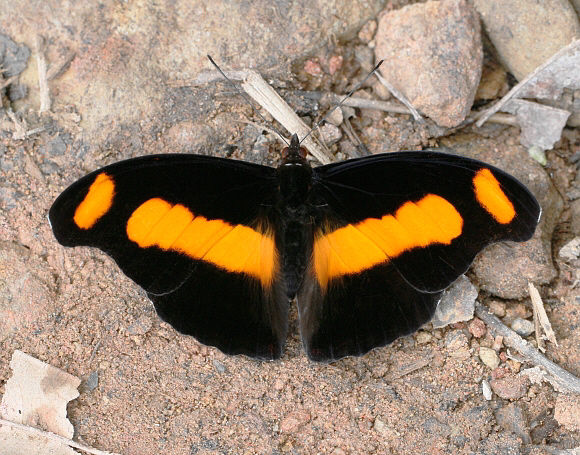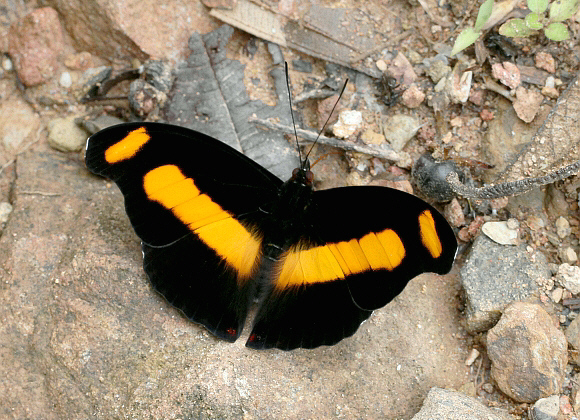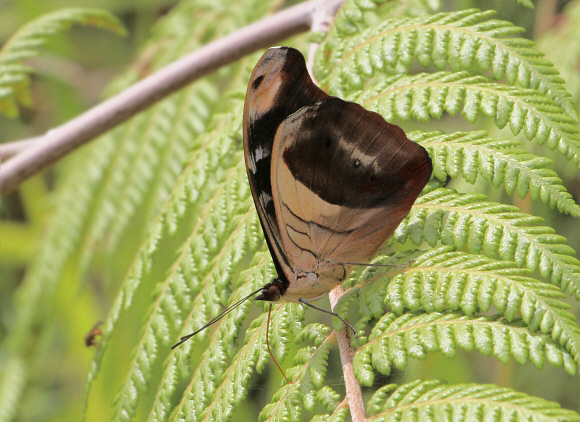 Catonephele chromis, Tatama NP, Colombia – Adrian Hoskins
Catonephele chromis, Tatama NP, Colombia – Adrian Hoskins
Introduction
The genus Catonephele contains 11 species, with wingspans of circa 65-80mm. The males are dark brown on the upperside with dazzling reflective orange patches which vary in size and shape from one species to another. The females are entirely different in appearance. In most species their dark brown wings are marked with linear rows of cream spots. The exception is numilia which has a large cream patch in the median area of the forewing and in which the basal and submarginal areas of the hindwings are deep red. Both sexes of all species have cryptic undersides in shades of brown.
This species often shares its habitats with the very similar Catonephele salambria, but on the latter the orange bar on the forewing is less bulbous, and that on the hindwing is broader. There are also major differences in the underside markings.
Catonephele chromis occurs from Costa Rica to Bolivia.
 Catonephele chromis godmani, Tatama NP, Colombia – Adrian Hoskins
Catonephele chromis godmani, Tatama NP, Colombia – Adrian Hoskins
Habitats
This species breeds in rainforest and cloudforest at altitudes between about 500-2000m.
Lifecycle
I have no information specific to chromis but the lifecycle is likely to be similar to that of a typical Catonephele species as follows: The eggs are barrel-shaped, white or yellowish, and laid singly on the foliage of seedling trees of Alchornea, Dalechampia or Veconcibea ( Euphorbiaceae ). The fully grown larvae are variable, some species being dark green mottled with white spots while others are black with maroon markings. In all species the larvae are adorned with prominent whorled spikes along the back and sides and a pair of metallic blue spines projecting from the head capsule. They rest with the body arched and the face appressed to the substrate. If molested by parasitoids or predators they wriggle violently. The pupa is dark green with brown or silvery wing pads. It is attached by the cremaster to leaves, with the body projecting laterally.
 Catonephele chromis godmani, Tatama NP, Colombia – Adrian Hoskins
Catonephele chromis godmani, Tatama NP, Colombia – Adrian Hoskins
Adult behaviour
The butterflies are usually encountered singly. Males perch on tree trunks, and bask on foliage or on fallen branches in light gaps, often less than a metre above ground level, and are reminiscent in behaviour of Nessaea. If disturbed they usually spend a few moments circling cautiously, but then resettle close to their original position. Females are scarcer, and usually seen when searching for oviposition sites along forest trails, but occasionally bask on sunlit paths.
Both sexes are attracted to rotting fruit and mammal dung. Males also imbibe mineralised moisture from forest tracks and roads.

Catonephele chromis godmani, Tatama NP, Colombia – Adrian Hoskins
